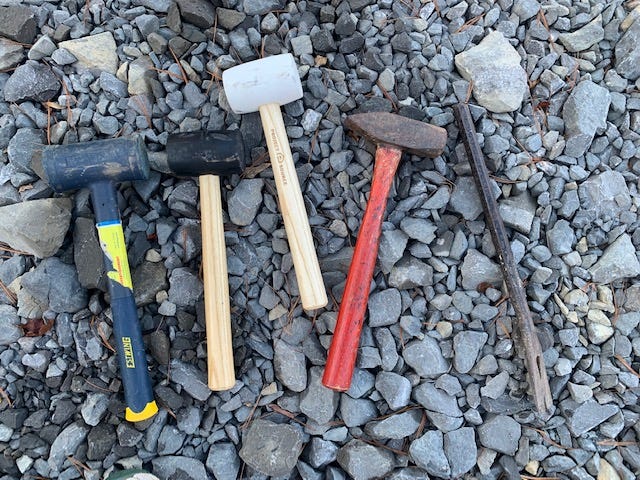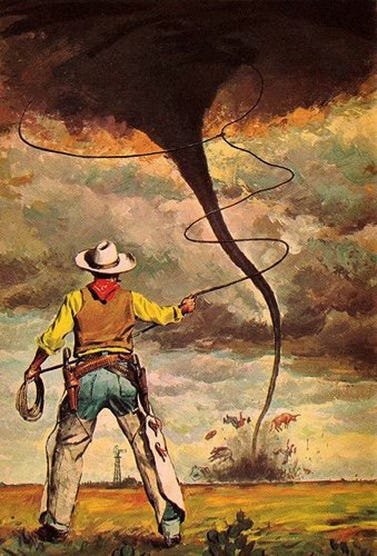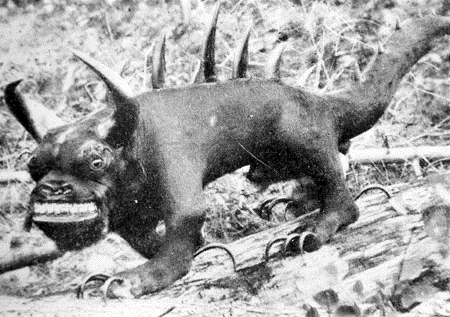Wherever you’re reading this, I appreciate your interest. As always, I invite new readers to become a free or paid subscriber with the button below. I would also appreciate a tip of any size with Stripe or with Paypal.
I just finished teaching a course “American Folk Tales” at the Mountaineer Homeschool Hub. We mostly go there so my kids can meet other kids, and I volunteered to teach some courses to make sure we could get together some kids in their age range (4-7).
The class met for an hour on Friday for six weeks. The idea was that each day we’d cover a story or two then have a related activity.
In keeping with the spirit of folk tales, I never read them a story. I told the story, based on what I could remember, sometimes blending elements of different versions I’d read or adding my own details. For visuals I drew or taped pictures on a big easel pad and brought a map of the US.
For anyone interested in doing something along those lines, I’ll describe the topics and activities, with some resources for versions of the stories.
Class 1: John Henry
I told them the story of John Henry and his famed contest with the drilling machine. Started by pointing out this was a West Virginia folk hero and asking who could find our state on the map. Also asked them if they’d heard of Alabama and knew what a slave was.
To give them a sense of what it means when people talk about Henry’s hammer ringing, I brought a pry bar and hammer from my workshop. It worked pretty well to keep their attention to clang on it for punctuation as I told the story. Also, when John Henry died, I made sure to fall out.
I brought my guitar as well and played them the ballad of John Henry. (This, my son says, is his main reason for thinking John Henry was a real guy: They wrote a song about him.) I went with these guitar chords.
For an activity, I brought a couple of medium- to lightweight mallets. I took them outside and had them take turns driving the pry-bar into the ground. These kids weren’t experienced with forming a line and waiting their turn, so that was lesson one. Then I coached the swinging just a little bit, having them trade weights of mallet and asking if they noticed that the heavier one was harder to swing but drove the bar further.
I think there was more interest in banging that piece of metal than a naïve person would guess — kids like simple, practical, adult-feeling activities. Some of the older boys had a mighty swing and I had to yank the bar out before it got lost in the ground.
I’d also found an uncolored drawing of John Henry online and gave it out as a coloring page.
My story hewed pretty close to the version in Zorn’s Classic American Folk Tales. I added the bit about Pollyanne taking up John’s hammer based on this version of the folk song by Sonny Terry and Brownie McGhee.
Class 2: Paul Bunyan
Started by having them find the states of Maine, Minnesota, and Washington on the map. I explained the stories came from the woodlands of the North, stretching from one coast to the other. I asked them if they knew what a lumberjack was — most didn’t — and explained the job.
We talked about Paul’s birth, finding Babe the blue ox, the story of the wily fox that was hiding in Paul’s beard, the story of the walking trees, of him creating Red Lake by wrestling with an Ojibwe hero, and the story of how he created Puget Sound and Mount Rainier.
Kids giggled at the names of his crew, like Johnny Inkpots and Sourdough Sam. One cried out at the walking trees part “What?! That doesn’t make any sense!!!” Another was mortified at the thought of cutting trees, so I had to explain that’s where homes come from, and finally mollified him with “well, he lived in the old days anyhow.”
Got the basics of Paul’s life story from Zorn’s Classic American Folk Tales. Got the stories of the fox, the walking trees, and Puget sound from McCormick’s Tall Timber Tales. The story of Red Lake was just the short version from Wikipedia, but the kids sure loved the detail about a lake being a buttprint. I’ve noticed kids love “and this is how it got to be this way” stories even if they know they’re bull. Maybe if I do it again I’ll track down a longer version.
For an activity, we played pin the tail on the blue ox. I drew Babe on some foam board and decorated his hide with bits of Velcro I colored blue. Cut the tail out of blue fabric and put Velcro on it.
I don’t know if it’s because they’re young or because they’re homeschool kids or because nobody does it these days, but for all 10 of them it was their first time with a variation of pin the tail on the donkey. It went over pretty well. Some were shy about being blindfolded but they all eventually tried it.
Class 3: Coyote and Bobcat
Started by pointing out this story was an old story, going back to before people came over from England or Europe. Showed the region of the Great Plains and Great Basin on the map, explained there were many tribes there with stories about Coyote. Explained that Coyote was a trickster, and that people everywhere tell stories of tricksters — Loki, Reynard the Fox, Raven. One girl got excited that she had read about Raven elsewhere.
Told the story of how Coyote rescued all the animals that had been swallowed by a giant monster by tricking it into eating him then lighting a fire in its stomach. Told how Coyote was the one who first stole fire from the Fire Spirits with the help of his friends chipmunk, frog, squirrel, and wood. The key there was doing some exaggerated animal motions and noises — that really cracked them up. Finally told the story of Coyote and Bobcat stretching and disfiguring one another. One kid got excited at the explanatory implication: “That’s why they look like they look now!”
I got Coyote and Bobcat from Zorn’s Classic American Folk Tales. I found Coyote and the giant monster online here. And I got Coyote steals fire for man here.
For an activity, I brought in some silicon casts of real coyote and bobcat tracks. I get them from Nature Watch and my son has fun at home making different tracks in Playdo. For class I gave each kid a lump of Sculpy and told them to make their own set of tracks and take it home, have a grownup bake it, and then they could recognize if a coyote or bobcat came through their yard.
Class 4: Pecos Bill
Started by having someone find Texas on the map. Asked the kids if they knew what a cowboy was. Most didn’t!!! I know they’re young but yeesh. Explained the cowboys of the American West, then told how Pecos Bill was the ultimate cowboy, the one who invented the lifestyle.
I told of Bill’s origin, his riding a mountain lion and turning a rattlesnake into the first lasso. Told of him taming Widowmaker, of his roping a tornado and forcing the storm to end a drought, and of his romance with Slue-Foot Sue. I said he shot the stars out of the sky to impress her, leaving just the last one, and that’s why there’s a lone star on the Texas flag to this day. (This made a mom who used to live in Texas grin.) Told the story of Sue getting bucked to the moon by Widowmaker, and in my version, he rescues her and they lived happily ever after. My daughter chimed in, “That’s a happy ending!”
Mostly went along with Zorn’s Classic American Folk Tales but added the tornado story and some other elements from the stories on American Folkore.net and Legends of America.
For an activity, I took this lasso game idea from Raising Dragons. You tie a rope to a hula hoop and have them use it to lasso a basketball. They seemed to have fun with it for ten minutes but after that the novelty wore off for most of them and I just let them go play (socialization is our main reason for being there anyway). One boy kept practicing longer with the hoop lasso though and got pretty good at it.
Class 5: The Jack Tales
Started by asking them if they knew what the word Appalachia meant. Explained it was the mountains we lived in. Asked them if they’d heard of “Jack and the Beanstalk,” expecting it to be universal, but only like half of them seemed familiar. I said most people know that one, but Jack had a lot of other adventures that fewer remember. Told them these stories go way back to England, and one place they got kept alive was by the people who settled in the Appalachian Mountains.
Then told the story of “Jack and the Unicorn” (and boar and lion), followed by “Jack and the Flying Ship.” For “Jack and the Flying Ship,” I had pictures of all his crew — Hardy Hardhead, Speedwell, Harkwell, Seewell, Drinkwell, Eatwell, Shootwell — for the kids to look at. And, as I suspected would happen, each time the evil witch gave Jack a new challenge, kids would excitedly shout out which companion should be the one to take it up. They seemed pretty attentive despite this being one of the days I talked longest. I think the kids glom onto the characters as being something akin to superheroes. And Jack’s trickiness tickles them.
I went with the stories from Haley’s The Mountain Jack Tales.
Their activity this week was a little less inspired, but it went over well enough. I asked them to draw scenes from the story. I encouraged them to show and talk about their drawings, and one kid asked for helping learning to draw a ship.
Class 6: Monsters, Fearsome Critters, and Strange Creatures
It was our last class before Halloween, so I figured it was time for some monster madness. We started with Bigfoot, which they’d all heard of, though they’d never heard the story of Ape Canyon in Oregon.
Then went onto Chessie, the Chesapeake Bay monster, and Champ, the Lake Champlain monster. One boy had heard of Nessie and thought it was a plesiosaur, and one girl had learned about Chessie before. (Her exact phrasing was “Chessie was in my other class!” which made for a funny mental picture.) Chessie was also an excuse to remind me own children that half our family is from across the Bay.
Then told of the Thunderbird of American Indian legends and gave some examples of giant bird sightings — a flap in West Virginia in 1895 in which people were claiming hunters mauled and dogs taken, a woman in Illinois in 1977 who claimed a giant bird lifted her son off the ground and only let go when he struggled, and a man in West Virgnia in 2007 who saw an impossibly large bird eating roadkill on a dark night.
Keeping to the theme of flying scary things, I told them of the Snallygaster, a beast of Frederick County, Maryland. But to round it out with something funnier, I introduced the goofus bird, which flies backwards and, I told them, has a tendency to run into trees because of it.
From there we went on to the hoop snake, and I told how Pecos Bill once defeated one by steering it into a cactus. (There’s a Pecos Bill and hoopsnake book out there, but I haven’t read it, so I just made this one up).
Then we covered the fearsome critters of lumberjack country, including the agropelter and the hodag. I told how Paul Bunyan once caught and tamed a hodag, even got it to do tricks. But normal men’s only hope for defeating such a tough and ornery creature was to cut a deep notch into the tree it leaned against when sleeping, for a hodag that fell on the ground would never get up again. That, and they couldn’t stand the smell of lemon. My daughter piped up “You need to drink a lot of lemonade!”
All through this, an older girl was impatient for Mothman — I must have heard “Mothman” twelve times before I finally got to him. And get to him we did, discussing the first sightings in Point Pleasant. In my own kids’ headcannon, Mothman is a good guy (he has a name like Superman and Batman, right?), so I ended with the assurance he’s scary but not known to have hurt anyone, and some say maybe he was alright.
I got my stories of giant birds and the Mothman from Guiley’s Monsters of West Virginia.
For an activity, I tried to get them to collaborate on drawing a monster on the big presentation pad. I felt a little one-notes doing drawing two weeks in a row, but it made sense to me that anything designed by committee would be monstrous. Mixed response to the collective project: Some kids got into taking turns to add their spikes or tentacles to the creature, but others, including my son, preferred to just draw on their own. But we got some nice hoop snakes and hodags out of that, though. Little boys love drawing monsters.
At the dinner table that night my kids kept quizzing me on the hodag’s diet (mud turtles) and weaknesses (lemon!).
All in all it went pretty well and it was fun sharing stories with the young’ns. Also good to make sure my kids and other kids they know have some common cultural references outside of the DisneyMarvelTube overculture.
I’m scheduled to do another version of it in the future. Reckon we can get in Johnny Appleseed, Br’er Rabbit, and some more Jack tales.
Thanks for reading! Pass this on to any homeschoolers who might be interested. Feel free to leave something in the tip jar with Stripe or with Paypal.






